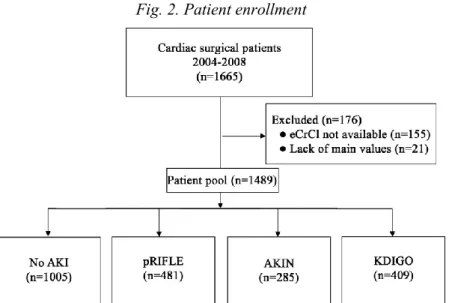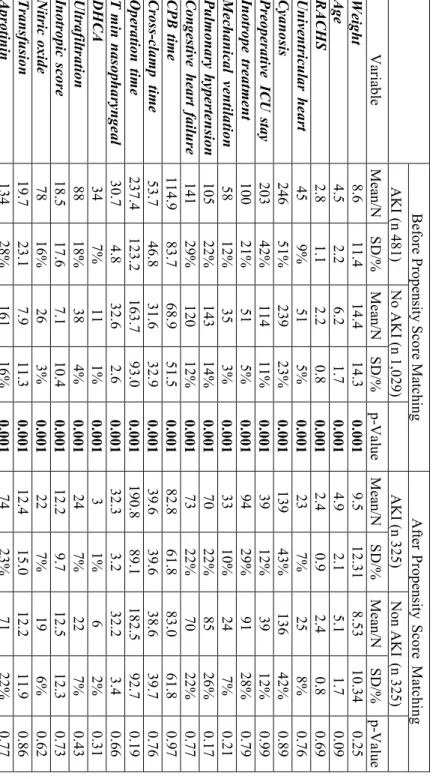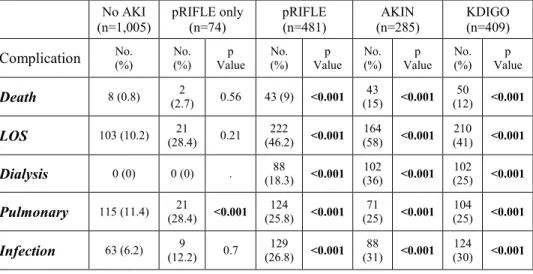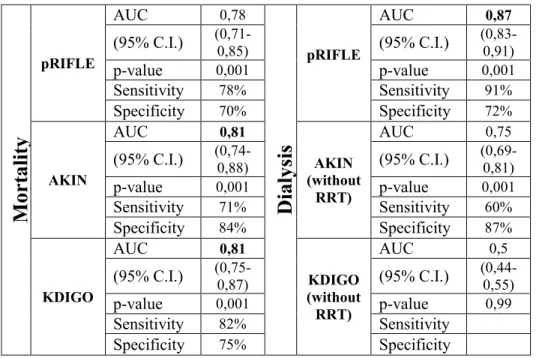Acute kidney injury after congenital cardiac surgery – novel findings and categorization methods
Ph.D. Thesis dr. Roland Tóth Semmelweis University
Doctoral School of Basic Medical Sciences
Supervisor: Dr. Andrea Székely, Ph.D., M.D.
Official reviewers: Dr. Barna Babik, Ph.D., M.D.
Dr. Attila Szijártó, Ph.D., M.D.
Head of the comprehensive exam committee:
Dr. Ferenc Horkay, D.Sc., M.D.
Members of the comprehensive exam committee:
Dr. Enikő Újhelyi, Ph.D., M.D.
Dr. Attila Kálmán, Ph.D., M.D.
Budapest 2015
I. INTRODUCTION
Acute kidney injury (AKI) is one of the most common and severe complications in cardiac surgery, occurs in one-third of patients undergoing cardiac operations. An AKI can be characterized as a sudden worsening in the renal function and its manifestations alternate between a minimal change in serum creatinine (SCr) and anuric renal failure. While the incidence rate for renal replacement therapy (RRT) is 1.1% to 1.4% after cardiac surgery, a much higher percentage suffer renal dysfunction that does not meet the criteria for acute hemodialysis. Acute kidney injury is associated with an increased complication rate, including both morbidity and mortality and the expenditure of other resources. Similar findings have been described in pediatric populations. The application of RIFLE (risk, injury, failure, loss and end-stage renal disease) classification has been validated in pediatric populations.
Although renal dysfunction and failure are known risks of pediatric cardiac surgery, accurate estimates are lacking of the incidence and the relationship among AKI and other complications.
In cardiac populations the pathomechanism of AKI is mostly caused by the alteration of renal blood flow, ischemia and diminished autoregulation. The cardiopulmonary bypass activates the inflammatory response and the large foreign surface and shear stress further consume the coagulation factors and damage the blood components. The presence of coexisting disease, hemodynamic instability and certain drugs such as furosemide or angiotensin convertase enzyme inhibitors, increase the likelihood of developing AKI. In patients with congenital heart disease undergoing cardiac surgery, cyanosis, young age, large volume and blood component shifts during cardiopulmonary bypass also contribute to diminished kidney function.
2
3
The Risk, Injury, Failure, Loss and End-Stage (RIFLE) assessment and more recently, the Acute Kidney Injury Network (AKIN) systems have been validated in pediatric populations. The use of different criteria to define AKI in children is a fundamental problem because of the difficulties in making comparisons across studies. The current Kidney Disease: Improving Global Outcomes (KDIGO) recommendations for AKI in children are based on a report of pediatric-modified RIFLE (pRIFLE) in 150 patients, aged older than 1 year at a single center and on extrapolation from adult data. Analyses of the adult data from AKIN and RIFLE have led to the KDIGO proposal of a combined system, because AKIN detects some patients that have not been detected by RIFLE but only those of low risk. However, pRIFLE, which uses estimated creatinine clearance (eCCl), overcomes some of these issues in pediatrics, it is surprising that KDIGO recommends combining AKIN and pRIFLE without further analysis in a pediatric cohort.
II. AIMS
The purpose of this study was to determine the occurrence of AKI in a large retrospective cohort of pediatric patients using the validated pediatric- modified RIFLE (pRIFLE) criteria. We aimed to determine the relationship of AKI with other complications after cardiac surgery.
This report addresses the issue with a comparison of the utility of the KDIGO, pRIFLE and AKIN classification systems, three clinical measures of acute kidney injury in a pediatric cardiac surgical population. We hypothesized that the validated and previously standardized pRIFLE system would still provide the best results in the early detection of AKI.
3
III. METHODS
After Institutional Review Board approval (TUKEB 189/2008), data were studied from a prospectively collected database of consecutive pediatric (<18 years) patients undergoing cardiac surgery and admitted to our cardiac intensive care unit (ICU) between January 1, 2004 and December 31, 2008.
The board waived the requirement for informed consent by the parent. During the study period 1,510 cardiac surgeries were performed. In case of patients who underwent more than 1 operation during the index hospitalization only the first operation was considered for the present analysis.
The database collection form contains 5 sections completed consecutively by a cardiologist (preoperative and postoperative parts), anesthesiologist, surgeon and intensivists until the discharge of the patient. The cohort was matched to the Department of Biochemistry database through the use of patient identifiers and the operation dates. Cardiac surgical procedures were graded as class 1–6 by complexity, applying the Risk Adjustment for Congenital Heart Surgery, version 1 (RACHS) method. The cumulative index of inotropic support was quantified by the modified Wernovsky score. Low output syndrome was defined as hepatomegalia, oliguria, tachycardia and when the systolic blood pressure sank under the age-related normal value and had a base excess lower than 4 mmol/L or lactate above 2 mmol/L in 2 consecutive arterial blood samples. Pulmonary failure was defined as noninfectious, nonvascular oxygenation problems (atelectasis, pneumothorax, chylothorax and phrenic paresis). Serious infection was defined as sepsis, deep sternal wound infection, or positive blood culture and death was defined as in-hospital death after arrival at the ICU. Renal replacement therapy was defined as a need for peritoneal or hemodialysis support. All patient outcomes included in the
4
5
database were determined separately by an intensivist and a cardiologist at the discharge of the patient from the hospital. The Schwartz formula was used to determine the estimated creatinine clearance by the following equation:
eCCl (ml/min/1,73m2): [k] x [height (cm)] / serum creatinine (mg/dl) where k 0.55; if 1 year, 0.45; if male and older than 13 years, 0.7.
The AKI was defined according to the next three categories:
pRIFLE Risk was defined as an eCCl decrease of 25% or UO less than 0.5 mL/kg/hour/8 hours;
pRIFLE Injury was defined as an eCCl decrease of 50% or UO less than 0.5 mL/kg/hour/16 hours
pRIFLE Failure was defined as an eCCl decrease of 75%, an eCCl less than 35 mL/minutes/1.73 m2 or UO less than 0.3 mL/kg/hour/24 hours or anuric for 24 hours.
AKIN I category was defined as an increase of the SCr by 0.3 mg/dL or more or an increase to 150-200% of the preoperative value in 48 hours
AKIN II was defined as an increase to 200-300% of the preoperative value in 48 hours
AKIN III was defined as an increase to more than 300% of the reference value, a value greater than 4.0 mg/dL, or the need for RRT.
KDIGO stage III was additionally defined by a decrease in eCCl to less than 35 mL/min/1.73 m2. (KDIGO I-II were similar to AKIN I-II.)
5
Categorical variables were summarized as frequencies and percentages.
Continuous variables were expressed as means and standard deviations or medians and interquartile ranges for parametric and nonparametric variables, respectively. The unadjusted associations of the three thresholds of pRIFLE with morbidities (LOS, pulmonary, infection, mechanical ventilation greater than 72 hours, RRT, length of ICU stay) and death rates were calculated with the Wilcoxon rank sum test.
Since patients with AKI and without AKI were not comparable with respect to important covariates, propensity score methods were used to match patients who had AKI to patients who had no AKI. The propensity score was constructed with multivariable logistic regression, with AKI as the binomial dependent variable and all measured covariates that could be related to AKI (20 variables) as predictor variables. The model’s reliability and predictive ability were measured with the Hosmer-Lemeshow test and the c-index, respectively.
The propensity score derivation model was used to calculate the propensity score for each patient and based on this score each patient who had AKI was matched to a unique control patient. A 5¡1 computerized greedy matching technique was employed for this matching process whereby cases were first matched to controls that had a propensity score that was identical in all 5 digits.
Those that did not match were then matched to controls on 4 digits of the propensity score. This continued down to a 1-digit-match on propensity score for those that remained unmatched.
Measured covariates and outcomes in the matched group were compared between the two groups with paired t test or Wilcoxon signed rank test for continuous variables and McNemar test for categorical variables. The procedure yielded 325 well-matched pairs.
6
7
The p-values for categorical variables are based on a two-sided X2 or the Fisher exact test (as appropriate), comparing AKI patients vs. non-AKI patients. The p-values for continuous variables are based on a t test or the Wilcoxon rank sum test. The unadjusted associations of the three thresholds of KDIGO, pRIFLE and AKIN categories with death were calculated using univariate analysis. We further assessed the RIFLE and AKIN definitions in different age groups on their ability to predict in-hospital mortality and dialysis by means of calculation of the area under the receiver operating characteristic (AUC-ROC) curve. The SPSS 16.0 statistical software (SPSS Inc Chicago, IL) was used. A p value of less than 0.05 was considered statistically significant.
IV. RESULTS
The analyzed database contained the data of 270 (17.9%) neonates, 517 (34.2%) infants and 723 (47.9%) children. In the study population of 1,510 patients, 481 (31.9%) patients had AKI as assessed by the pRIFLE criteria. Of those 1,510 patients, 173 (11.5%) met the risk threshold, 26 (1.7%) met the injury threshold and 282 (18.7%) met the failure threshold of AKI. Fifty-five patients (3.6 %) died; 4 (7.3%), 0 and 39 (70.9%) were from the risk, injury and failure groups, respectively and 12 patients (21.8%) had no AKI. Renal replacement therapy was needed in 96 (6.4%) patients and 8 (0.5% of the study population, 8.3% of the RRT group) patients did not meet the pRIFLE criteria.
Patients with AKI underwent more complex surgery with long cardiopulmonary bypass duration were more likely to have cyanosis and needed mechanical ventilation before surgery than those without renal dysfunction. Acute kidney injury patients received higher amounts of inotropic drugs and transfusions and needed nitric oxide, steroids and aprotinin more
7
frequently. Patients in the failure group were younger and smaller and one-third of them underwent acute surgery and operations with rethoracothomy.
Preoperative eCCl in the failure group was lower compared to the non- AKI patients, while postoperative eCCl and creatinine levels measured either on the first or second postoperative days were significantly lower in each group compared to the non-AKI patients. There were no significant differences in the urine output compared to non-AKI patients, except for the risk group on the day of surgery and the failure group on the second postoperative day. In each AKI group the postoperative eCCl was lower than the baseline level. All three thresholds of AKI were associated with an increased length of mechanical ventilation and ICU stay.
Fig. 1. Postoperative complications and pediatric modified RIFLE categories
The propensity score derivation model, which included 22 variables, was reliable (Hosmer-Lemeshow test p=0.3) and discriminative (c-index=0.94).
By use of this model, 325 (of 481) AKI patients were matched to 325 control (of 1,021) non-AKI patients. The mean propensity scores for AKI and the non-
8
9
AKI groups were 0.367 and 0.377, respectively (p=0.99). The propensity score of the unmatched AKI group was 0.845. Before propensity matching AKI patients had higher mortality and morbidity compared to non-AKI patients.
After propensity matching occurrence of low cardiac output syndrome, a need for dialysis and infection was higher in the AKI group. Length of mechanical ventilation and ICU stay were also longer compared to the non-AKI patients.
Comparing the three classifications 481 (32.3%) patients had AKI according to the pRIFLE, 285 (19.1%) according to the AKIN and 409 (27.4%) to the KDIGO criteria; 74 (5%) patients had AKI classified by pRIFLE but not by AKIN or KDIGO. RRT was needed in 96 patients (6.4%), 54 patients (3.6%) died.
Fig. 2. Patient enrollment
9
Table 1. Group comparison before and after propensity matching Before Propensity Score Matching After Propensity Score Matching AKI (n 481)No AKI (n 1,029) AKI (n 325) Non AKI (n 325)VariableMean/NSD/%Mean/NSD/%p-Value Mean/NSD/%Mean/NSD/%p-ValueWeight 8.611.414.414.30.0019.512.31 8.53 10.34 0.25 Age4.52.26.21.70.0014.92.15.11.70.09 RACHS2.81.12.20.80.0012.40.92.40.80.69 Univentricular heart459%515%0.001237%258%0.76 Cyanosis24651%23923%0.00113943%13642%0.89 Preoperative ICU stay 20342%11411%0.0013912%3912%0.99 Inotrope treatment 10021%515%0.0019429%9128%0.79 Mechanical ventilation5812%353%0.0013310%247%0.21 Pulmonary hypertension10522%14314%0.0017022%8526%0.17 Congestive heart failure14129%120 12%0.0017322%7022%0.77 CPB time 114.983.768.951.50.00182.861.883.061.80.97 Cross-clamp time 53.746.831.632.90.00139.639.638.639.70.76 Operation time 237.4123.2163.793.00.001190.889.1182.592.70.19 T min nasopharyngeal 30.74.832.62.60.00132.33.232.23.40.66 DHCA347%111%0.0013 1%6 2%0.31 Ultrafiltration8818%384%0.001247%227%0.43 Inotropic score 18.517.67.110.40.00112.29.712.512.30.73 Nitric oxide 7816%263%0.001227%196%0.62 Transfusion19.723.17.911.30.00112.415.012.211.90.86 Aprotinin13428%16116%0.0017423%7122%0.77
11 Table 2. Comparison of outcomes in the nonmatched and matched groups Before Propensity Score Matching After Propensity Score Matching AKI (n 481)No AKI (n 1,029) AKI (n 325) Non AKI (n 325) VariableMean/NSD/%Mean/NSD/%p-ValueMean/NSD/%Mean/NSD/%p-Value Mortality438.9%121.2%0.001 175.2%8 2.5%0.09 Low cardiac output
22246.2%11511.2%0.001 11635.7%8024.6%0.002 Pulmonary failure12425.8%12211.9%0.001 7723.7%6620.3%0.63 Dialysi
s
8818.3%8 0.8%0.001 237.1%6 1.8%0.001 Infection10121.0%646.2%0.001 6921.2%4714.5%0.03 ICU sta
y 6.1 (3.4–9.2) 3.5 (1.7–4.5) 0.001 5.1 (2.9–7.9) 4.1 (2.2–7.1) 0.001 Mech. ventilation87(32–166)13(7–35)0.001 49(26–112)33(15–76)0.001
11
The patients with AKI classified by all three criteria underwent more complex operations with longer cardiopulmonary bypass durations, were more likely to have cyanosis and congestive heart failure and needed preoperative mechanical ventilation more frequently than those without renal problems. AKI patients had higher inotropic scores, received more transfusions, needed nitric oxide, steroids, ultrafiltration and aprotinin more frequently.
AKI was associated with an increased risk of morbidity and death regardless of the classification system applied. The patients classified with an AKI by only pRIFLE had a greater risk of pulmonary complications.
Table 3. Postoperative complications according to the different AKI categories
No AKI
(n=1,005) pRIFLE only
(n=74) pRIFLE
(n=481) AKIN
(n=285) KDIGO
(n=409)
Complication No. (%) No. (%) Value p No. (%) Value p No. (%) Value p No. (%) Value p
Death 8 (0.8) (2.7) 2 0.56 43 (9) <0.001 (15) 43 <0.001 (12) 50 <0.001
LOS 103 (10.2) 21
(28.4) 0.21 222
(46.2) <0.001 164
(58) <0.001 210
(41) <0.001
Dialysis 0 (0) 0 (0) . (18.3) 88 <0.001 102 (36) <0.001 (25) 102 <0.001
Pulmonary 115 (11.4) 21
(28.4) <0.001 124
(25.8) <0.001 71
(25) <0.001 104
(25) <0.001
Infection 63 (6.2) (12.2) 9 0.7 (26.8) 129 <0.001 (31) 88 <0.001 (30) 124 <0.001
We noted that AKIN stage I (a SCr elevation 1.5 times from baseline) is different to a 25% decrease in the CCl (pRIFLE-Risk category), which explains the 74 missed patients (5%) by both SCr methods. A classification of KDIGO/AKIN stage I would therefore be equivalent to a decrease in CCl exceeding 33%.
12
13
Fig. 3. Percentage of serum creatinine increase by creatinine clearance decrease
In the entire population the KDIGO stage III (odds ratio [OR], 18.8;
95% confidence interval [CI], 9.6 to 36.6; p < 0.001), the AKIN stage III (OR, 38.3; 95% CI, 20.6 to 70.9; p < 0.001) and the pRIFLE failure group (OR, 13.6;
95% CI, 7 to 26.3; p < 0.001) were associated with increased mortality. The AUCs for death were similar (AUC, 0.81) to the KDIGO and AKIN systems in the entire population. Overall, 6.2% of the patients required RRT. ROC curve analysis using AKIN and KDIGO categories without the inclusion of RRT criteria showed weaker prediction value than pRIFLE.
13
Table 4. Adjusted risk models for death and dialysis (pRIFLE, AKIN)
V. CONCLUSIONS
We found that AKI occurs relatively frequently in the pediatric cardiac population. Measuring the change in eCCL is a useful tool with which to identify patients with AKI in the postoperative period. The incidence of postoperative complications increased with the severity of pRIFLE categories.
Using propensity score methods we successfully matched a relatively large number of patients who had AKI after pediatric cardiac surgery to a group of patients who did not have AKI. We found that patients who had AKI had a higher rate of low cardiac output syndrome, dialysis and infection than patients without AKI. Length of mechanical ventilation and ICU stay were also longer in patients in the AKI group compared to patients in the non-AKI group.
M ort al it y
pRIFLE
AUC 0,78
D ia ly si s
pRIFLE
AUC 0,87
(95% C.I.) (0,71-0,85) (95% C.I.) (0,83-0,91)
p-value 0,001 p-value 0,001
Sensitivity 78% Sensitivity 91%
Specificity 70% Specificity 72%
AKIN
AUC 0,81
AKIN (without
RRT)
AUC 0,75
(95% C.I.) (0,74-0,88) (95% C.I.) (0,69-0,81)
p-value 0,001 p-value 0,001
Sensitivity 71% Sensitivity 60%
Specificity 84% Specificity 87%
KDIGO
AUC 0,81
KDIGO (without RRT)
AUC 0,5
(95% C.I.) (0,75-0,87) (95% C.I.) (0,44-0,55)
p-value 0,001 p-value 0,99
Sensitivity 82% Sensitivity
Specificity 75% Specificity
14
In our pediatric cardiac surgical population the distribution of AKI categories was not homogenous. This discrepancy can be partly due to the failure definition of the pRIFLE criteria; ie, the eCCL less than 35 mL/minute/1.73 m2 is very close to the normal value of the neonate and infant population and small changes in eCCl can cluster these patients into the failure group. However, after propensity matching the AKI group had higher morbidity compared to the non-AKI group. Therefore, this eCCl threshold might be interpreted as a dangerous cutoff value below which the kidney could not satisfactorily eliminate waste products.
Our results showed increased sensitivity of the pRIFLE system in detecting AKI. pRIFLE alone in young infants was superior to other assessments of AKI. It raises the need for further assessment of AKI measures in the full range of children and not only extrapolating adult data before the implementation of KDIGO as the recommended AKI measure for children.
The pediatric-validated pRIFLE adds eCCl using the Schwartz formula making it more appropriate for pediatric patients. The AKIN criteria do not use the CCl calculation and thus, the classification is simpler. The recently validated version for a pediatric cardiac population aged younger than 90 days omitted the need for dialysis from the stage III classification because peritoneal dialysis was also used to treat fluid overload and not solely as a treatment for kidney failure and we have included this classification in our analysis. Our results showed that, unsurprisingly, the removal of RRT from the stratification of AKIN and KDIGO reduced identification of patients at risk for dialysis.
Our data support the calculation of eCCl in the pediatric population to more accurately reflect renal function than using SCr alone. pRIFLE is the most sensitive measure of AKI in pediatric patients. The AKIN system was more specific for AKI patients, whereas KDIGO and pRIFLE were more sensitive, particularly pRIFLE, in the early detection of AKI.
15
VI. PUBLICATIONS Publications related to the thesis
Articles
1. Toth R, Breuer T, Cserep Z, Lex D, Fazekas L, Sapi E, Szatmari A, Gal J, Szekely A. (2012) Acute kidney injury is associated with higher morbidity and resource utilization in pediatric patients undergoing heart surgery.
Ann Thorac Surg, 93: 1984-1990.
2. Lex DJ, Toth R, Cserep Z, Alexander SI, Breuer T, Sapi E, Szatmari A, Szekely E, Gal J, Szekely A. (2014) A comparison of the systems for the identification of postoperative acute kidney injury in pediatric cardiac patients. Ann Thorac Surg, 97: 202-210.
Other publications Book chapter
1. Hauer D, Toth R, Schelling, G. Endocannabinoids, “new-old” mediators of stress homeostasis. In: Chouker A. (editor), Stress Challenges and Immunity in Space – From Mechanisms to Monitoring and Preventive Strategies. Springer-Verlag, Berlin-Heidelberg, 2012: 106-126.
Articles
1. Feuerecker M, Hauer D, Toth R, Demetz F, Holzl J, Thiel M, Kaufmann I, Schelling G, Chouker A. (2012) Effects of exercise stress on the endocannabinoid system in humans under field conditions. Eur J Appl Physiol, 112: 2777-2781.
2. Hauer D, Weis F, Campolongo P, Schopp M, Beiras-Fernandez A, Strewe C, Giehl M, Toth R, Kilger E, Schelling G. (2012) Glucocorticoid- endocannabinoid interaction in cardiac surgical patients: relationship to early cognitive dysfunction and late depression. Rev Neurosci, 23: 681- 690.
16
3. Toth R, Szanto P, Prodan Z, Lex DJ, Sapi E, Szatmari A, Gal J, Szanto T, Szekely A. (2013) Down syndrome and postoperative complications after paediatric cardiac surgery: a propensity-matched analysis. Interact Cardiovasc Thorac Surg, 17: 691-697.
4. Lex DJ, Toth R, Cserep Z, Breuer T, Sapi E, Szatmari A, Gal J, Szekely A. (2013) Postoperative differences between colonization and infection after pediatric cardiac surgery-a propensity matched analysis. J Cardiothorac Surg, 8: 166.
5. Cserep Z, Losoncz E, Toth R, Toth A, Juhasz B, Balog P, Vargha P, Gal J, Contrada RJ, Falger PR, Szekely A. (2014) Self-rated health is associated with the length of stay at the intensive care unit and hospital following cardiac surgery. BMC Cardiovasc Disord, 14: 171.
6. Lex DJ, Szanto P, Breuer T, Toth R, Gergely M, Prodan Z, Sapi E, Szatmari A, Szanto T, Gal J, Szekely A. (2014) Impact of the insulin and glucose content of the postoperative fluid on the outcome after pediatric cardiac surgery. Interv Med Appl Sci, 6: 160-169.
17





